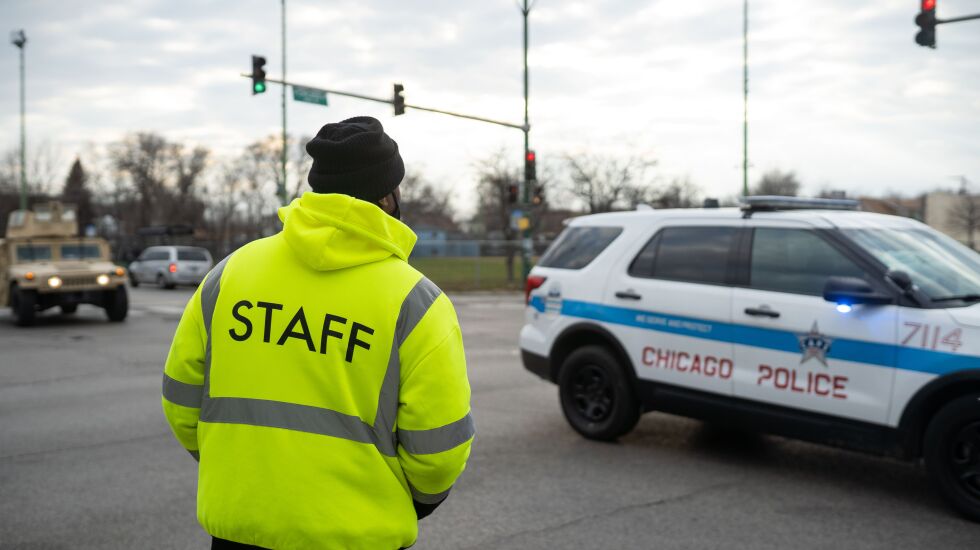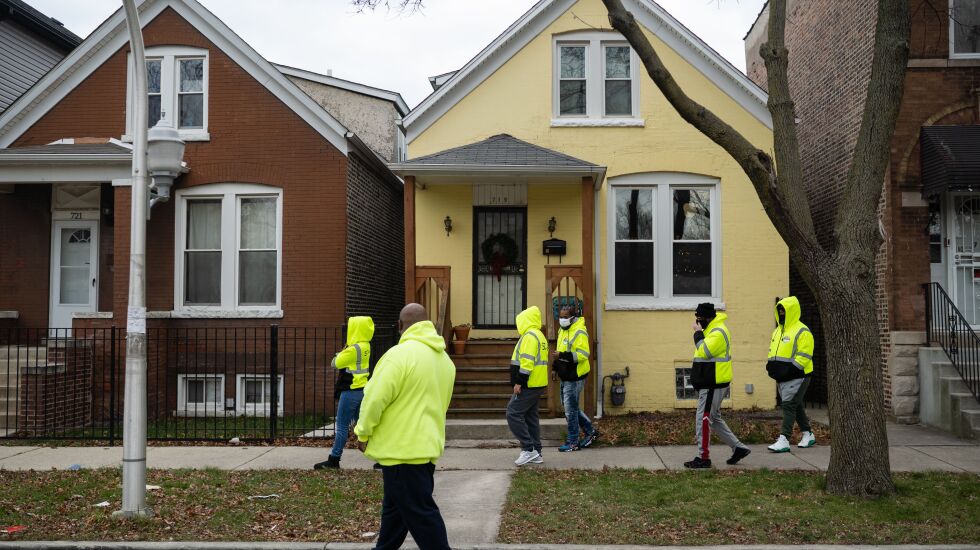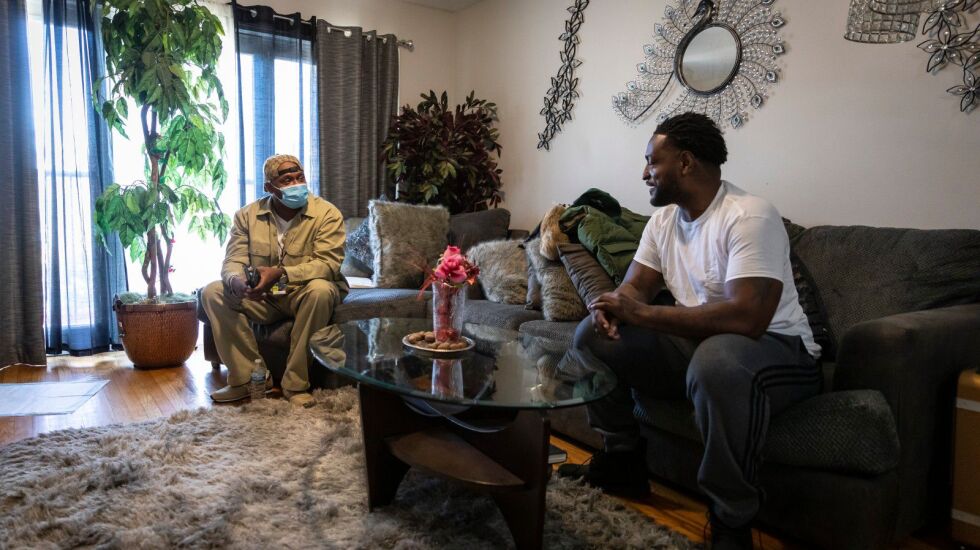
In the summer of 2016, the Chicago White Sox were in the middle of their fourth losing season in a row. But their owner, Jerry Reinsdorf, had something more pressing on his mind: Chicago gun violence.
The city was experiencing a massive increase in shootings, up 50% compared to the year before.
“You just couldn’t get away from the headlines in the city and you know, ‘Chicago’s the homicide capital of the world’ and ‘What’s happening in Chicago?’ and I mean, the homicides were off the charts, and it was scary, and it was alarming,” said Christine O’Reilly, vice president of community relations for the team.
In the middle of that 2016 season, O’Reilly remembers Reinsdorf calling her into his office inside the White Sox stadium and telling her, “‘We have to do something about this, the city is in crisis.’”
At Reinsdorf’s behest, O’Reilly organized a meeting with all of the owners of Chicago’s major sports teams, it led to the owners creating the Chicago Sports Alliance charity fund and deciding to invest in READI Chicago, a program that seeks to give jobs and therapy to the men most likely to shoot or be shot in the city.
Reinsdorf wasn’t alone in his thinking. People across the city were concerned about the violence spike, but Chicago’s outrage over the 2014 police killing of Laquan McDonald forced the conversations to go beyond police as the solution.
While Reinsdorf was shepherding money toward READI Chicago, the Emerson Collective, funded by the billionaire widow of Apple’s Steve Jobs, bankrolled a very similar program, Chicago CRED. At the same time, Metropolitan Family Services, a massive and long-running nonprofit, was organizing small anti-violence groups under one big umbrella called Communities Partnering 4 Peace, or CP4P.
The combination of big money and political might gave birth to a movement that would, in just five years, spur government investment, earn praise at the White House and provide a semi-permanent infrastructure allowing for an unprecedented bet on former gang members to heal their own communities.
‘Absolute crisis and dire need’
All the efforts starting around 2016 and 2017 relied on street outreach workers, people from the community who are tasked with connecting with the people most likely to shoot or be shot.
Chris Patterson, the head of Illinois’ Firearm Violence Prevention Office, said the efforts were geared toward giving people “trapped in the cycle of violence” a reason to hope.
“I’m a victim of gun violence, I know people who, unfortunately, have committed crimes that they now regret. And you know, most people want to take that back, right? They were acting out of an impulse, they were acting from a place of trauma … And there was never any help to help those individuals. Right. And so we want to reverse that,” Patterson said. “We want to have a conversation with people who are not only victims of violence, but drivers of violence. We think that if given the opportunity, we can turn that mindset around.”
Roseanna Ander, executive director of the Crime Lab, said the “really shocking and enormous spike in gun violence” in 2016 forced many in the city to search for new solutions.
“I mean, we’re a research organization, but it was very hard to separate out the sort of sense of absolute crisis and dire need to do something,” Ander said. “Even before 2016, Chicago, by any kind of rational, humane standards, had a very long way to go to make the city safe and healthy for everybody. But to have things be exacerbated so much, so suddenly, with no end in sight. It really felt like we had to jump in with both feet.”
Ander’s colleague at the Crime Lab, Monica Bhatt, said those early days were filled with urgency, but also promise.
“I remember in 2016, 2017, there would be a motley crew of people from different sectors. So philanthropy, some of the larger nonprofits, some of the community-based street organizations, the research organizations,” Bhatt said. “We used to have design sessions at the Kusanya Cafe down in Englewood, and really come together to say, ‘Okay, who is the right target population, given that the age of gun violence victims is so much older than people think and where services are, you know, what is the right program model?’”

In the five years since, philanthropy has invested $100 million in the efforts. CP4P has grown from eight organizations serving nine neighborhoods, to 14 groups in 27 neighborhoods.
Eddie Bocanegra who was the first head of READI Chicago and now has a position in the U.S. Justice Department said Chicago is lucky that private organizations were willing to step up.
“That is unheard of, over $100 million from philanthropy alone,” Bocanegra said. “It’s unfortunate, right, that when I look back, and where was government at? Where was the federal government at? Where was local government at? But the fact that philanthropy was bold enough to say, ‘We see this as an emerging issue, and we’re not going to wait any longer’ … I am super impressed by where Chicago stands right now.”
‘We have to do more’
The concept at the core of this community-based violence intervention has been around for a long time.
Northwestern University professor Andrew Papachristos traces it back to the Chicago Area Project in the 1930s. That “delinquency prevention program” was supported by academics from the University of Chicago and addressed crime as a “product of deteriorating neighborhoods.” Part of the program involved something called “curbstone counseling” in which community street workers would meet with young gang members and try to give them informal guidance to help avoid violence and other criminal activity.
“Part of what the Chicago Area Project really aimed to do was build bridges … between these folks that were detached [and] institutions. And then it kind of evolved from there. So it was a community endeavor, and then it became a delinquency prevention program and then it became gang prevention,” Papachristos said.
The idea got a refresh about two decades ago with CeaseFire, which later became Cure Violence. Cure Violence hired “credible messengers” in communities with high rates of violence, usually former gang members, and paid them to intervene in gang disputes. The organization also tackled gun violence as a public health problem instead of a criminal one.
READI, CRED and CP4P all rely on similar credible messengers to find and connect with high-risk people. Vaughn Bryant, who runs CP4P, said they took a lot of lessons from Cure Violence.
“I don’t think we would be where we are without the foundation that they laid,” Bryant said. The groups that are part of CP4P provide job training, therapy and legal aid to the people they serve.
“We have to do more than just stop shootings and killings, immediate conflicts, we have to have a way for people to move their lives forward. So that, you know, a week from now, a month from now, they’re not back in the same conflict, doing the same thing over again,” Bryant said of the services CP4P offers.
Another key difference is the consistency of funding. Cure Violence largely relied on year-by-year grants. Sometimes that would mean they’d lose funding for weeks or months right as summer violence was starting to spike. Often it meant laying people off and then attempting to rehire them once more funding came in.
Sirenzo Strong, an anti-violence worker for the Breakthrough organization in East Garfield Park, remembers being asked to do violence intervention for Cure Violence years ago, but turning it down.
“Back then it was scarce. You know, you work six months, you might not work another six months, or you might work a year and then you’re off a year, or whatever the case may be, because of funding,” Strong said.
The support from major philanthropic groups has meant much more stability in recent years. When Strong was offered a position at Breakthrough, they promised him at least two straight years of employment. He accepted.

‘A religious moment’
Three years ago, about 250 people packed into the South Shore Cultural Center’s solarium for what felt like a pep rally.
The city’s major anti-violence organizations were gathering to announce an ambitious goal: a 20% reduction in murders in 2020.
Papachristos remembers feeling like the event was the culmination of something, and the start of a new chapter.
“That was a religious moment, man,” Papachristos said.
Over the previous three years, community members, researchers and funders had been building the city’s violence prevention infrastructure. Now all the major players were gathered in one place. Duncan, from Chicago CRED, gave a speech about the need to think big. Bryant rallied the crowd.
The strength and influence of the movement was growing. The year before, CRED’s Susan Lee had been named Chicago’s deputy mayor of public safety. In the years to follow, Bocanegra would be plucked from READI to advise the U.S. attorney general on reducing urban gun violence and Patterson, a former outreach worker, would go to work for Ill. Gov. JB Pritzker, running the state’s violence prevention efforts.
In 2021, Pritzker announced he was routing a quarter-of-a-billion dollars in federal funds to community anti-violence groups. The city of Chicago and Cook County have also committed millions to the organizations.
Duncan celebrated the progress in an essay last year.
“All told, in 2022 Chicago will invest roughly $188 million in public and private dollars on community-based violence intervention programs. Six years ago, that number was much closer to zero,” Duncan wrote in the Stanford Social Innovation Review.
‘It hurts to see that’
Of course, the city did not achieve that 20% reduction in murders in 2020. The COVID-19 pandemic hit two months after the South Shore rally. The George Floyd uprisings came a few months later.
Chicago, like many American cities, suffered an increase in gun violence. Shootings and murders increased to levels even higher than that awful 2016 that started the movement. The fact that the increase happened across the country gave researchers in Chicago reason to believe it didn’t have to do with the success or failure of the community-based anti-violence efforts.
On a program-by-program basis, studies of the efforts have been promising.
A Northwestern University analysis of Chicago CRED found that people who finished the CRED program were less likely to be arrested or shot. University of Chicago researchers have also seen indications that men who participate in READI Chicago are less likely to be shot or arrested for a shooting, but those findings are not statistically significant. Papachristos’s research found CP4P prevented nearly 400 shootings and murders between 2017 and 2021.
That’s meaningful for individuals, but not enough to make much of a dent in a city that sees more than 3,000 shootings a year.
Bocanegra, the senior adviser to the principal deputy assistant attorney general, said even with the surge of support in recent years, there still aren’t enough resources devoted to the anti-violence work to expect more of an impact.
The millions spent on this kind of work pales in comparison to the roughly $2 billion per year Chicago spends on police.
Bocanegra believes when evaluating the anti-violence programs, the focus should be on what the research says so far.
“These results suggest that we’re tapping into something with great potential. But we’re not investing enough in this,” Bocanegra said.
He said Department of Justice officials know more needs to be invested.
“But we also know that this is historical. We know that this is a starting point for us to start building the field,” Bocanegra said. “And I will tell you that I’ve always been an underdog champion. And to me this feels like we’re the underdog.”
Patrick Smith is a criminal justice reporter for WBEZ. This story was reported as part of WBEZ’s Motive Podcast. Subscribe to Season 5 of Motive on Spotify, Apple or wherever you get your podcasts.







